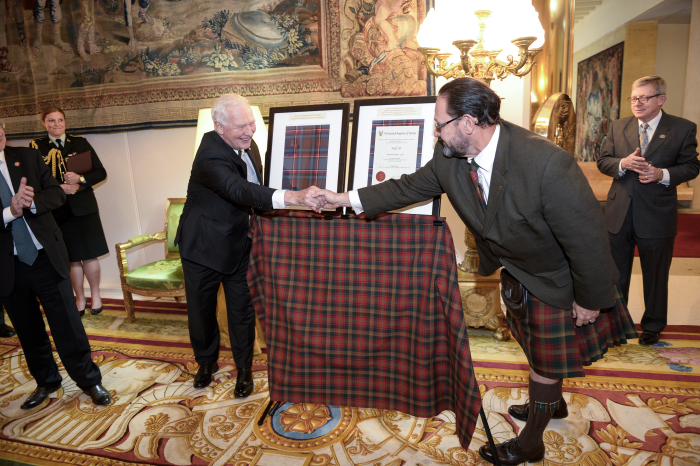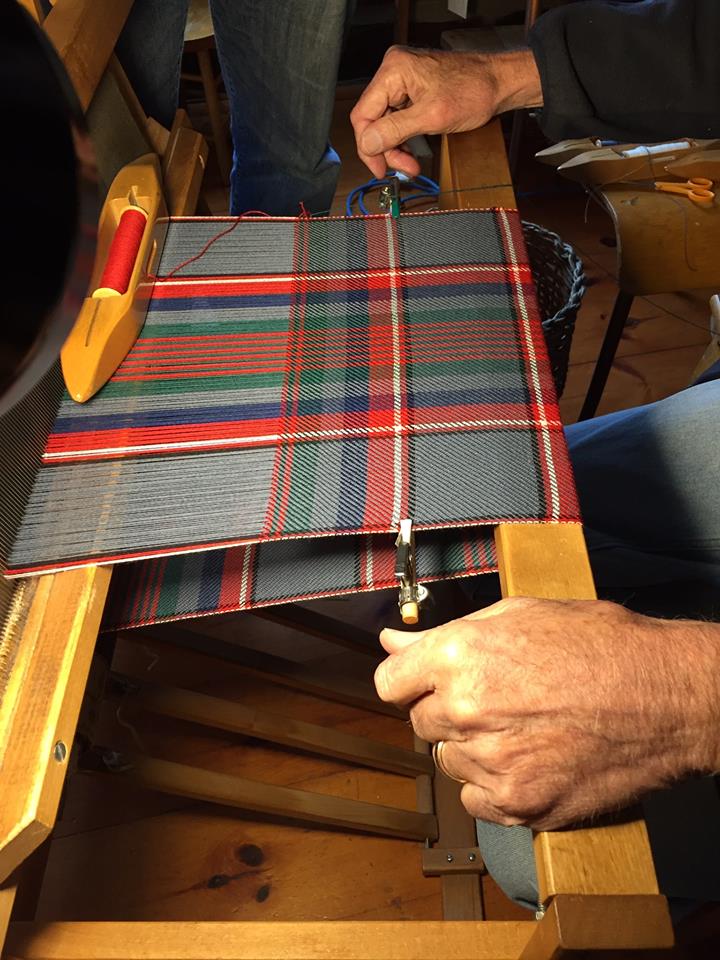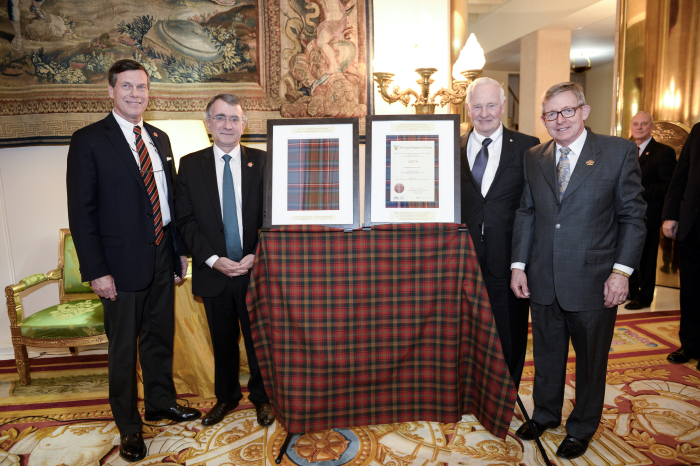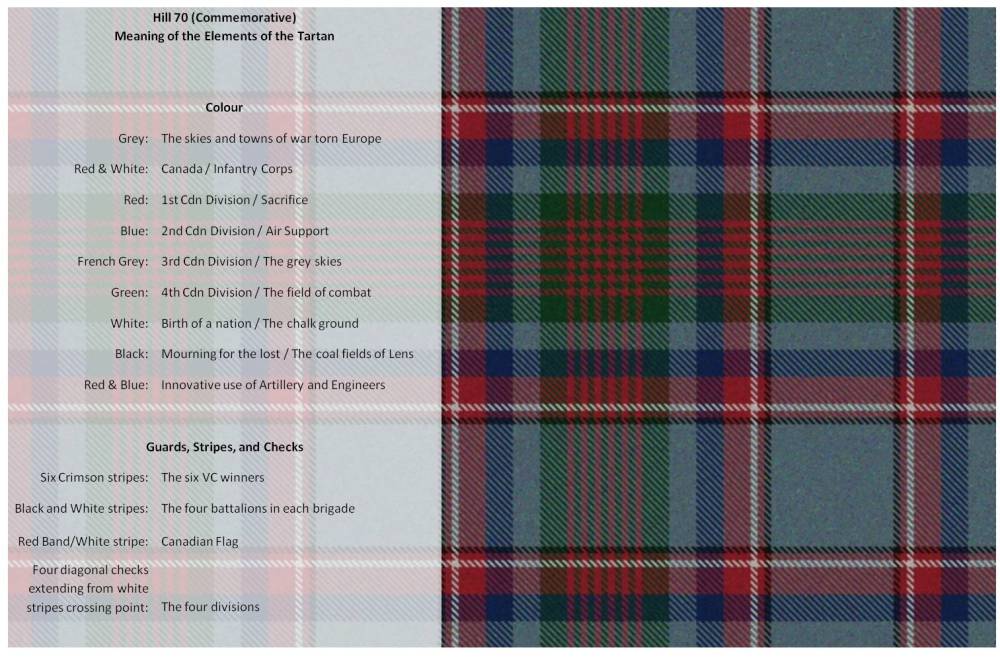In 2015, the Hill 70 Memorial Project commissioned a tartan for the Battle of Hill 70, and Ron was the perfect man for the job! He has also designed a family tartan,
Roach, and a few personal projects which can be found
here. The interview was conducted by the blog's author Cristina, whose questions are in bold with Ron's answers below. Thank you Ron, for your time!
Ron, it is so nice to speak with you! Please tell us a little bit about yourself and how you came to be a Tartan designer? Is this your full-time pastime, a passion project or something else?
Ron: The pleasure is mine, Cristina. I have always had an interest in things Celtic and a few years back, while researching a tartan I came across on online tartan design tool. So, I played around with it a bit and realized that there was now an art form I could do without having to colour inside the lines. It started as a successful project to register and weave a Roach tartan, when I got compliments on it I decided to try my hand at a few more and had a team of friends and family do critiques on them for me. Word got around and people started approaching me to do tartan designs – that is when Crossing Tartans was created with my brother Brian, who is a phenomenal researcher. It is a part time pursuit, but one that complements my Celtic music hobby and keeps my head clear for other consulting work.
 His Excellency the Right Honourable David Johnston, unveiling the Hill 70 Tartan with Ron Roach at the French Embassy in February 2016.
What is so special about tartans to you?
His Excellency the Right Honourable David Johnston, unveiling the Hill 70 Tartan with Ron Roach at the French Embassy in February 2016.
What is so special about tartans to you?
Ron: It all goes back to my roots in Cape Breton, a mother of Scottish decent and a father who was an Irish-Acadian. Celtic music was part of the fabric (no pun intended) around home, I played guitar in high school and joined the Royal Military College band and became the bass drummer. So, kilts and tartans were a normal part of my life. I became more interested in their development and history as I read more about Highland culture and history through the years. I have always been fascinated by symbols, like flags and crests, and the association with cultures, countries, and clans. Tartans today are much like a coat of arms, or a corporate brand, with symbolism, literally, woven into the cloth.
When you are commissioned or inspired to create a tartan, where do you begin?
Ron: The first question I always ask is: why do you want a tartan and what will you use it for? That affects a number of design factors such as the tone that the tartan will produce and the size of the check. Then I ask for family or corporate history to get a feel for context and story that the tartan will become an integral part of. It is here that I determine important colours and themes.
How does the process go from there?
Ron: Step-by-step, it goes as follows:
- Once I have determined the general idea - for instance if it is a corporate tartan that is going to be used on mugs and scarves, it would be a smaller check with bright colours; if a family tartan that is going to be worn as kilts on a daily basis, I would use larger checks and more subdued colour tones – I then lay out the “sett” in shades of grey.
- The “sett” is the combination of checks, stripes and bands that makes the pattern of the tartan
- By working in monotone, it allows me to work on the symbolism in the weave itself. An example in the Hill 70 Tartan is the six stripes representing the six VC winners. It also allows me to place the colours more easily. More than six colours in a Tartan makes it extremely busy. Everywhere the colours cross each other, another colour is formed. So a two colour check has three colours. Six colours produce 15 blended colours for a total of 21.
- I normally produce three distinct options using the same colours. This allows the client to focus on the design of the sett, once that is decided we can then play with the colours.
- As most things, though, the process is not linear. So, there is a lot of trial and error in order to produce a tartan with meaning that is also pleasing to the eye. I also bounce the design off of Brian throughout the process as he researches any background that will add to the project.
- Before having the design registered, I always recommend that a sample be woven to ensure the client is happy.
Do you weave the tartan yourself, or do you bring it to someone else for that step?
That is a story in itself, but the outcome was that I met Mr Robert Hinchley, from White Lake (near Arnprior) who weaves tartan scarves. How he weaves the scarves does not match, exactly, a twill weave that you would find in kilt fabric; however, the quality of his work, and the type of wool he uses makes it more than acceptable as a sample. The bonus is that if I got something wrong in the design, I still have a very comfortable scarf. Once the client approves, the drawing and a swatch from Bob’s loom are sent to the Scottish Register of Tartans for approval and registration. Et, voila, an official tartan.
Crossing Tartans also produces a “story” to go with the tartan; it adds background and additional meaning to the design and the reasons behind the design. I think this is a unique product among Tartan designers.
 Robert Hinchley, weaving the Hill 70 Tartan.
How did the Hill 70 Tartan come to be?
Robert Hinchley, weaving the Hill 70 Tartan.
How did the Hill 70 Tartan come to be?
As most things tend to happen, completely by accident. I was attending the same function as Mark Hutchings in March of 2015. We hadn’t seen each other in some time, so we were catching up – he told me all about the Hill 70 Memorial Project. I had actually turned to speak with some else when it hit me like a freight train, I turned back around and asked Mark if the project wanted a tartan. So, the Hill 70 Tartan was conceived at a St Patrick’s reception at the residence of the Irish Ambassador. I am not sure who is the father and who is the mother, but we were both there.
 The Hill 70 Project's Chair, Colonel Mark Hutchings, Ambassador of France to Canada Mr. Nicolas Chapuis, His Excellency David Johnston, and Mr. Ronald Roach with the Hill 70 tartan.
What was your thinking in selecting the colours and design that you did?
The Hill 70 Project's Chair, Colonel Mark Hutchings, Ambassador of France to Canada Mr. Nicolas Chapuis, His Excellency David Johnston, and Mr. Ronald Roach with the Hill 70 tartan.
What was your thinking in selecting the colours and design that you did?
It was not easy, given the amount of symbolism that I wanted to evoke and the restriction of six colours. The story of each colour and the design is explained in the image below.
 What has been your favourite tartan to design?
What has been your favourite tartan to design?
That is like asking who is your favourite child. Each design has something unique about it. I was thrilled to evoke the Order of St John in Leo Regimbal’s tartan, and see his reaction. Both Roach and Hill 70 have emotion woven in at some level for different reasons. I am working on one now that will have some very special symbolism in the design.
Can you choose a favourite tartan designed by someone else?
That is an easy one, MacDonald of Clan Ranald, my mother’s clan. In terms of a recent design, though, Mr. Karsten Moeller designed his own personal tartan and produced a very classic subdued design. See that one
here.
If someone would like to order a tartan, how do they go about it?
There are a good number of great designers out there. All of the weaving houses in Scotland have a design service. Then of course, you can always contact me, I would be happy to take on new projects, whether to design a new tartan, adapt an existing one, or do research into an appropriate existing tartan for you to wear.
Thank you so much Ron, for your time and for sharing your passion with us!